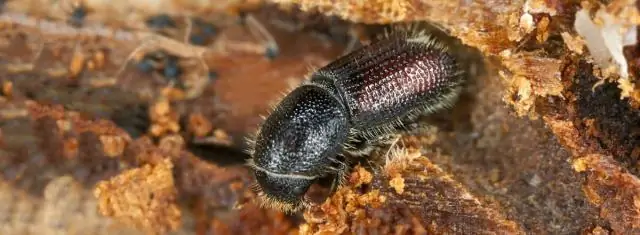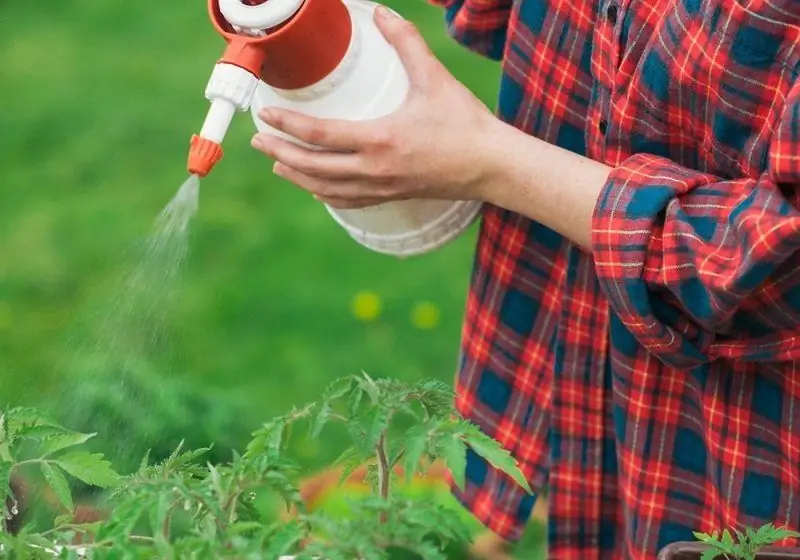
Table of contents:
- Author Bailey Albertson [email protected].
- Public 2023-12-17 12:53.
- Last modified 2025-01-23 12:41.
Salt from late blight on tomatoes: friend or foe?

Late blight is the most dangerous disease of tomatoes, practically not amenable to treatment. But it can be completely prevented. Traditionally, powerful chemicals are used for this purpose, but there are many simpler remedies, one of which is table salt.
How salt helps with late blight of tomatoes
It is important to understand that table salt (sodium chloride) cannot cure late blight, but it can slow down the development of the disease somewhat. From the point of view of prevention, this is a fairly effective means of minimizing the risk of disease. The fact is that an ordinary solution of table salt has a neutral reaction of the environment and is not able to affect the viability of the fungus that causes the disease. But when tomato plants are sprayed with a solution of salt of a sufficiently high concentration, a thin but durable protective film is formed on the surface of leaves and fruits. It does not allow infection to penetrate, it is an ordinary mechanical barrier.

Already only the bushes that have taken root in the garden can be sprayed with a salt solution: if you choose the right concentration, the result will even be invisible to the eyes
You might think that the film should not be dense and impenetrable. This is not so: in dry weather, it fulfills its role. However, it is clear that table salt easily dissolves at the first rain or illiterate watering (on the leaves). Therefore, in wet weather, such prevention will have to be performed systematically. And here lies a huge minus of funds: after all, soil salinization does not lead to anything good. If you overdo it with salt, then you will have to take measures to wash it out from the upper soil layers to the lower ones, or restore the soil condition by sowing siderates. Therefore, it is difficult to say which will come out safer: several treatments with modern fungicides or weekly application of sodium chloride.
Video: effective drugs for late blight
How to dilute and use salt in the fight against late blight on tomatoes
There are various recommendations for the use of table salt in tomato plantings. However, you should not take loading doses when there are no signs of late blight yet. So, this disease usually begins to manifest itself in the second half of summer, when intense rains begin to pour in conditions of a large difference in day and night temperatures, and dew often falls in the morning. But the first processing of tomatoes should be done at the very beginning of summer, when the seedlings will take root and continue to grow in the beds. At this time, a concentration of sodium chloride of about 50 g per bucket of water (10 L) is sufficient.

Any table salt used in the kitchen is suitable.
Spraying is repeated at least once a month, but in unprotected soil, this will have to be done after each moderate rain. The treatment is carried out in the morning to create favorable conditions for the formation of a protective film.
If the first signs of late blight are noticed, the concentration of the solution is increased at least twice. However, before processing, you should carefully tear off the damaged leaves and remove the fruits with traces of the disease. With a significant spread of phytophthora, up to 250 g of salt is dissolved in a bucket of water. It should be understood that such shock doses can generally dry out the remaining foliage, but they will stop the course of the disease and spur the ripening of the set fruits.
There are recommendations to dissolve salt in water heated to 30 … 35 o C. This does not make much sense: sodium chloride is a rare example of a substance, the solubility of which hardly changes with increasing temperature. The required amount of salt will normally dissolve in water and at room temperature.
Before pouring into the sprayer, the solution should be filtered: even edible salt can contain large insoluble impurities. After careful removal of damaged leaves and fruits, the whole plant is thoroughly sprayed with the prepared solution. It is necessary to process both the top and bottom of the leaves, stems and fruits.

Any convenient sprayer is suitable for processing
Late blight on tomatoes is almost impossible to cure, but the onset of the disease can be prevented. Even ordinary table salt can help in this, but its abilities should not be overestimated.
Recommended:
How To Get Rid Of A Bark Beetle Or A Grinder Beetle In The House, How To Process The Space

Ways of penetration of a beetle into wooden buildings and what harm it can cause. How to recognize the presence of a bark beetle. Insect killing methods
Processing Gooseberries From Powdery Mildew In Spring: When And What Is Better To Process

The value of treating gooseberries against powdery mildew. Terms and conditions of work. Preparations and folk remedies for the treatment and prevention of spheroteca
Why Late Sleep Is Dangerous - Negative Consequences For A Person

Why you need to go to bed before 23:00. Dangers of late sleep. How to train yourself to go to bed earlier
Spraying Tomatoes From Late Blight In The Greenhouse And Open Field

What is late blight and what does it look like. Preventive spraying of tomatoes with folk remedies. Treatments with biologicals and inorganic fungicides
Is It Possible To Spray Tomatoes During Flowering Than To Process

Why spray tomatoes during flowering. Preparations and folk remedies for foliar feeding. Rules for the preparation of solutions and the frequency of processing
